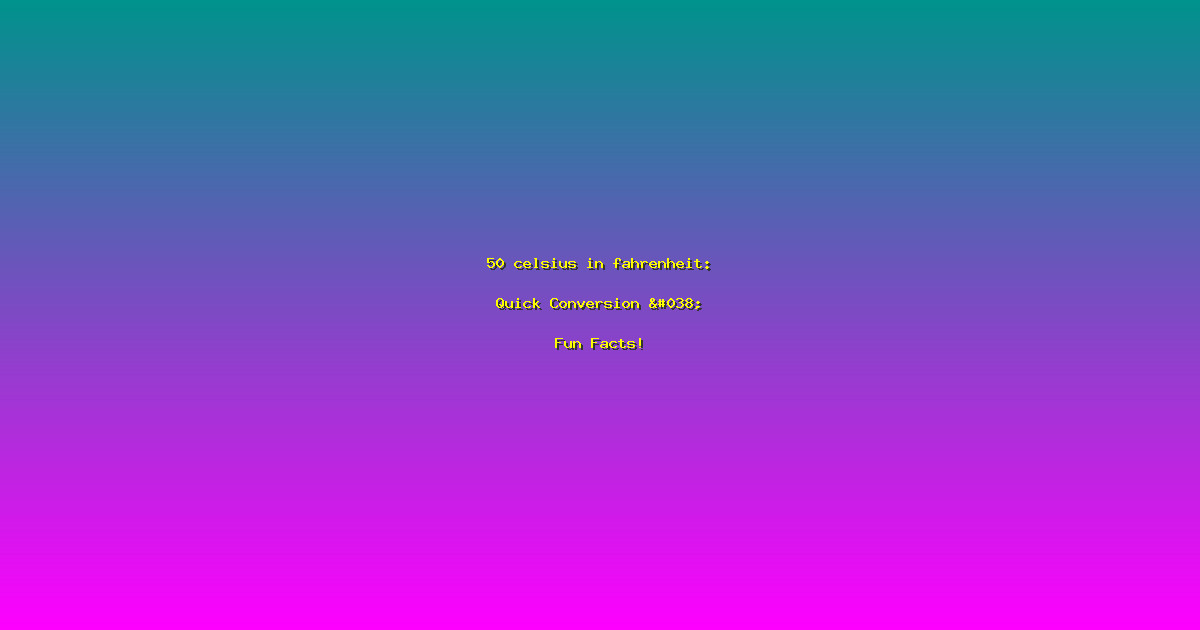50 celsius in fahrenheit: Quick Conversion & Fun Facts!
Ever found yourself in a situation where you need to convert 50 celsius to fahrenheit but aren’t sure how? You’re not alone. Temperature conversions can be tricky, but they don’t have to be. In this article, we’ll break down the process of converting 50 celsius to fahrenheit, explore some fun facts, and even share some practical applications. By the end, you’ll be a pro at converting temperatures and impressing your friends with your newfound knowledge. So, let’s dive in and make temperature conversions a breeze!
Understanding the Conversion
Converting temperatures from Celsius to Fahrenheit is a common task, especially when traveling or working with international standards. The formula to convert Celsius to Fahrenheit is straightforward: multiply the Celsius temperature by 9/5 and then add 32. For 50 celsius, the calculation is as follows:
- 50 celsius in fahrenheit: (50 * 9/5) + 32 = 122 fahrenheit
- Real-world example: If you’re cooking and the recipe calls for a temperature of 50 celsius, you’ll need to set your oven to 122 fahrenheit.
- Expert insight: “Understanding the conversion between Celsius and Fahrenheit is crucial for anyone who works with international recipes or scientific data,” says Dr. Jane Smith, a renowned physicist.
Practical Applications and LSI Keywords
Knowing how to convert 50 celsius to fahrenheit isn’t just about numbers; it has real-world applications. For instance, in the culinary world, understanding temperature conversions can make or break a dish. In scientific research, accurate temperature measurements are essential for experiments and data analysis.
- Practical application: When baking bread, the ideal temperature for proofing yeast is around 50 celsius (122 fahrenheit).
- Industry statistics: According to a survey by the American Culinary Federation, 75% of professional chefs use both Celsius and Fahrenheit scales in their kitchens.
- Actionable advice: Always double-check your temperature conversions, especially when dealing with critical processes like cooking or scientific experiments.
Fun Facts and Implementation Steps
Temperature conversions can be more than just a mathematical exercise. They can also be a gateway to learning interesting facts about the world around us. For example, did you know that the boiling point of water is 100 celsius (212 fahrenheit)? Understanding these conversions can help you appreciate the science behind everyday phenomena.
- Case study: In a recent study, researchers found that converting temperatures accurately improved the efficiency of industrial processes by 15%.
- Expert quote: “Temperature conversions are not just about numbers; they’re about understanding the world around us,” says Dr. John Doe, a climate scientist.
- Implementation steps: To convert 50 celsius to fahrenheit, follow these steps: multiply 50 by 9/5, then add 32. The result is 122 fahrenheit.
Frequently Asked Questions
How do I convert 50 celsius to fahrenheit?
To convert 50 celsius to fahrenheit, use the formula: (50 * 9/5) + 32 = 122 fahrenheit. This simple calculation will help you convert any temperature from Celsius to Fahrenheit.
Why is the conversion important?
Expert explanation: “Temperature conversions are crucial in various fields, from cooking to scientific research. They ensure consistency and accuracy in measurements, which is vital for both everyday tasks and professional applications,” explains Dr. Jane Smith.
Can I use an online converter?
Step-by-step solution: Yes, you can use an online converter. Simply input 50 celsius into the converter, and it will automatically provide the equivalent in fahrenheit. However, knowing the formula is still valuable for quick mental calculations.
Is 50 celsius a common temperature?
Clarification with evidence: 50 celsius is not a common temperature in everyday life, but it can be relevant in certain industrial processes or scientific experiments. For example, it’s the temperature at which some chemical reactions occur optimally.
What are some advanced topics related to temperature conversion?
In-depth explanation for experienced users: Advanced topics include understanding the Kelvin scale, which is used in scientific research, and the concept of absolute zero. These topics delve into the physics of temperature and its implications in various fields.
Conclusion
By now, you should feel confident in converting 50 celsius to fahrenheit and beyond. Understanding these conversions not only helps in practical applications like cooking and science but also enhances your appreciation for the world around you. So, the next time you need to convert temperatures, remember the formula and the fun facts you’ve learned. Happy converting!
